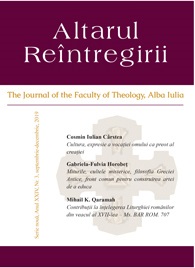Some observations regarding clergy and lay communion in the Romanian Orthodox Church (Câteva observații privind Împărtășirea clerului și a laicilor în Biserica Ortodoxă Română)
Some observations regarding clergy and lay communion in the Romanian Orthodox Church
Author(s): Mihai RăducăSubject(s): Christian Theology and Religion, Theology and Religion
Published by: Facultatea de Teologie Ortodoxă Alba Iulia
Keywords: Liturgy; byzantine rite; multiple chalices; Eucharist; synaxis; liturgical reform;clericalization;
Summary/Abstract: In the practice of the Romanian Orthodox Church the clergy and lay communion is still a moment within the Divine Liturgy that requests more attention and a proper approach from the ministers and the hierarchy. A limit case encountered is that when on the occasions of large eucharistic synaxes the faithful are not permitted to commune with the Holy Mysteries immediately after the admonition “With fear of God” and are left waitting until the end of the Liturgy. Thus, an eucharistical apartheid is being promoted by the servants. This fact contradicts the aim of the Divine Liturgy pointed out by Saint Nicholas Cabasilas and with the text of the prayers of the Liturgy where the priest asks God to “grant Communion of Your most pure Body and precious Blood to us, and through us to all the people”. The lay communion is disseized from the service and placed outside it in order to spear some time for other (optional) liturgical/non-liturgical elements. Moreover, when there are many celebrants, the communion of the clergy often lasts overmuch prolonging the koinonia which is fully captured by the servants. The communion of the priests that are assisting is also an issue. For such and many other liturgical shortcomings some possible solutions are analyzed in the present paper. Liturgical pragmatic solutions and theological foundations could be brought forward from Church Tradition, historical witnesses, contemporary liturgical research and from the current practice of other Orthodox Churches.
Journal: Altarul Reîntregirii
- Issue Year: XXIV/2019
- Issue No: 3
- Page Range: 163-172
- Page Count: 10
- Language: Romanian

